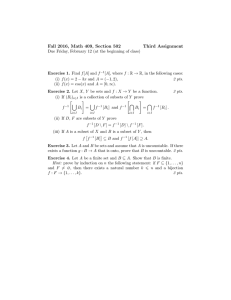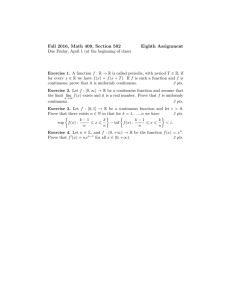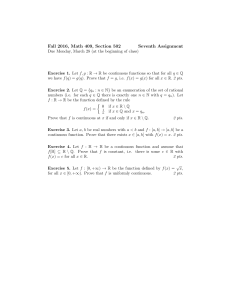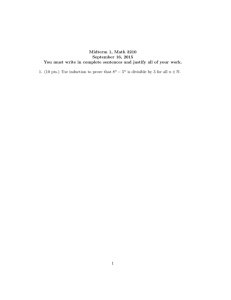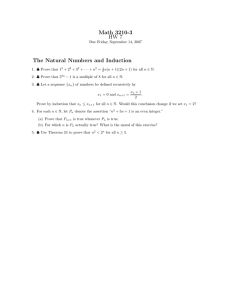Problem
advertisement
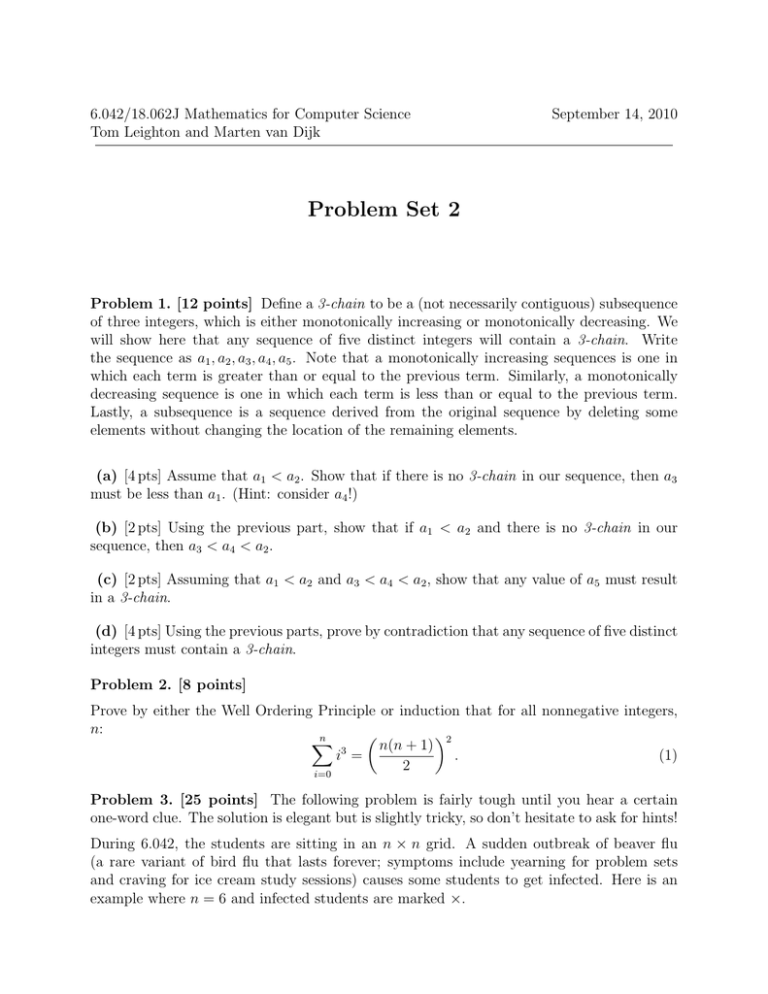
6.042/18.062J Mathematics for Computer Science Tom Leighton and Marten van Dijk September 14, 2010 Problem Set 2 Problem 1. [12 points] Define a 3-chain to be a (not necessarily contiguous) subsequence of three integers, which is either monotonically increasing or monotonically decreasing. We will show here that any sequence of five distinct integers will contain a 3-chain. Write the sequence as a1 , a2 , a3 , a4 , a5 . Note that a monotonically increasing sequences is one in which each term is greater than or equal to the previous term. Similarly, a monotonically decreasing sequence is one in which each term is less than or equal to the previous term. Lastly, a subsequence is a sequence derived from the original sequence by deleting some elements without changing the location of the remaining elements. (a) [4 pts] Assume that a1 < a2 . Show that if there is no 3-chain in our sequence, then a3 must be less than a1 . (Hint: consider a4 !) (b) [2 pts] Using the previous part, show that if a1 < a2 and there is no 3-chain in our sequence, then a3 < a4 < a2 . (c) [2 pts] Assuming that a1 < a2 and a3 < a4 < a2 , show that any value of a5 must result in a 3-chain. (d) [4 pts] Using the previous parts, prove by contradiction that any sequence of five distinct integers must contain a 3-chain. Problem 2. [8 points] Prove by either the Well Ordering Principle or induction that for all nonnegative integers, n: ( )2 n ∑ n(n + 1) 3 i = . (1) 2 i=0 Problem 3. [25 points] The following problem is fairly tough until you hear a certain one-word clue. The solution is elegant but is slightly tricky, so don’t hesitate to ask for hints! During 6.042, the students are sitting in an n × n grid. A sudden outbreak of beaver flu (a rare variant of bird flu that lasts forever; symptoms include yearning for problem sets and craving for ice cream study sessions) causes some students to get infected. Here is an example where n = 6 and infected students are marked ×. 2 Problem Set 2 × × × × × × × × Now the infection begins to spread every minute (in discrete time-steps). Two students are considered adjacent if they share an edge (i.e., front, back, left or right, but NOT diagonal); thus, each student is adjacent to 2, 3 or 4 others. A student is infected in the next time step if either � the student was previously infected (since beaver flu lasts forever), or � the student is adjacent to at least two already-infected students. In the example, the infection spreads as shown below. × × × × × × × × × × × × × × × × × × × × × × × × × × × × ≤ ≤ × × × × × × × × × × × × × × × × × × In this example, over the next few time-steps, all the students in class become infected. Theorem. If fewer than n students in class are initially infected, the whole class will never be completely infected. Prove this theorem. Hint: When one wants to understand how a it is usually a good strategy to (1) identify initial stage, and (2) prove, by induction on preserved at every time-step. So look for a remains invariant as time proceeds. system such as the above “evolves” over time, an appropriate property of the system at the the number of time-steps, that the property is property (of the set of infected students) that If you are stuck, ask your recitation instructor for the one-word clue and even more hints! Problem 4. [10 points] Find the flaw in the following bogus proof that an = 1 for all nonnegative integers n, whenever a is a nonzero real number. Proof. The bogus proof is by induction on n, with hypothesis P (n) ::= →k � n. ak = 1, Problem Set 2 3 where k is a nonnegative integer valued variable. Base Case: P (0) is equivalent to a0 = 1, which is true by definition of a0 . (By convention, this holds even if a = 0.) Inductive Step: By induction hypothesis, ak = 1 for all k ≥ N such that k � n. But then an+1 = an · an 1·1 = = 1, an−1 1 which implies that P (n + 1) holds. It follows by induction that P (n) holds for all n ≥ N, and in particular, an = 1 holds for all n ≥ N. Problem 5. [10 points] Let the sequence G0 , G1 , G2 , . . . be defined recursively as follows: G0 = 0, G1 = 1, and Gn = 5Gn−1 − 6Gn−2 , for every n ≥ N, n � 2. Prove that for all n ≥ N, Gn = 3n − 2n . Problem 6. [20 points] In the 15-puzzle, there are 15 lettered tiles and a blank square arranged in a 4 × 4 grid. Any lettered tile adjacent to the blank square can be slid into the blank. For example, a sequence of two moves is illustrated below: A B C D E F G H I J K L M O N � A B C D E F G H I J K L M O N � A B C D E F G H I J L M O K N In the leftmost configuration shown above, the O and N tiles are out of order. Using only legal moves, is it possible to swap the N and the O, while leaving all the other tiles in their original position and the blank in the bottom right corner? In this problem, you will prove the answer is “no”. Theorem. No sequence of on the right. A E I M moves transforms the board below on the left into the board below B F J O C D G H K L N A B C D E F G H I J K L M N O (a) [2 pts] We define the “order” of the tiles in a board to be the sequence of tiles on the board reading from the top row to the bottom row and from left to right within a row. For example, in the right board depicted in the above theorem, the order of the tiles is A, B, C, D, E, etc. Can a row move change the order of the tiles? Prove your answer. 4 Problem Set 2 (b) [2 pts] How many pairs of tiles will have their relative order changed by a column move? More formally, for how many pairs of letters L1 and L2 will L1 appear earlier in the order of the tiles than L2 before the column move and later in the order after the column move? Prove your answer correct. (c) [2 pts] We define an inversion to be a pair of letters L1 and L2 for which L1 precedes L2 in the alphabet, but L1 appears after L2 in the order of the tiles. For example, consider the following configuration: A B C E D H G F I J K L M N O There are exactly four inversions in the above configuration: E and D, H and G, H and F , and G and F . What effect does a row move have on the parity of the number of inversions? Prove your answer. (d) [4 pts] What effect does a column move have on the parity of the number of inversions? Prove your answer. (e) [8 pts] The previous problem part implies that we must make an odd number of column moves in order to exchange just one pair of tiles (N and O, say). But this is problematic, because each column move also knocks the blank square up or down one row. So after an odd number of column moves, the blank can not possibly be back in the last row, where it belongs! Now we can bundle up all these observations and state an invariant, a property of the puzzle that never changes, no matter how you slide the tiles around. Lemma. In every configuration reachable from the position shown below, the parity of the number of inversions is different from the parity of the row containing the blank square. row row row row 1 2 3 4 A B C D E F G H I J K L M O N Prove this lemma. (f ) [2 pts] Prove the theorem that we originally set out to prove. Problem 7. [15 points] There are two types of creature on planet Char, Z-lings and Blings. Furthermore, every creature belongs to a particular generation. The creatures in each generation reproduce according to certain rules and then die off. The subsequent generation consists entirely of their offspring. Problem Set 2 5 The creatures of Char pair with a mate in order to reproduce. First, as many Z-B pairs as possible are formed. The remaining creatures form Z-Z pairs or B-B pairs, depending on whether there is an excess of Z-lings or of B-lings. If there are an odd number of creatures, then one in the majority species dies without reproducing. The number and type of offspring is determined by the types of the parents � If both parents are Z-lings, then they have three Z-ling offspring. � If both parents are B-lings, then they have two B-ling offspring and one Z-ling offspring. � If there is one parent of each type, then they have one offspring of each type. There are 200 Z-lings and 800 B-lings in the first generation. Use induction to prove that the number of Z-lings will always be at most twice the number of B-lings. Hint: You may want to use a stronger hypothesis for the induction. MIT OpenCourseWare http://ocw.mit.edu 6.042J / 18.062J Mathematics for Computer Science Fall 2010 For information about citing these materials or our Terms of Use, visit: http://ocw.mit.edu/terms.
